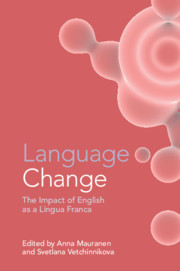Book contents
- Language Change
- Language Change
- Copyright page
- Contents
- Figures
- Tables
- Contributors
- Acknowledgements
- Abbreviations
- Introduction
- Part I Pooling Perspectives
- 1 Calling Englishes As Complex Dynamic Systems: Diffusion and Restructuring
- 2 English as a Lingua Franca in the Context of a Sociolinguistic Typology of Contact Languages
- 3 How Writing Changes Language
- 4 ELF and Translation As Language Contact
- 5 Present-Day Standard English
- 6 Beyond Language Change
- Part II Zooming in on ELF
- Index
- References
2 - English as a Lingua Franca in the Context of a Sociolinguistic Typology of Contact Languages
from Part I - Pooling Perspectives
Published online by Cambridge University Press: 17 December 2020
- Language Change
- Language Change
- Copyright page
- Contents
- Figures
- Tables
- Contributors
- Acknowledgements
- Abbreviations
- Introduction
- Part I Pooling Perspectives
- 1 Calling Englishes As Complex Dynamic Systems: Diffusion and Restructuring
- 2 English as a Lingua Franca in the Context of a Sociolinguistic Typology of Contact Languages
- 3 How Writing Changes Language
- 4 ELF and Translation As Language Contact
- 5 Present-Day Standard English
- 6 Beyond Language Change
- Part II Zooming in on ELF
- Index
- References
Summary
Different types of language evolve in situations of human social contact depending on the nature of the social contact, social structure and the speakers' attitudes towards the societies in contact. Three socially defined language types, each forming a continuum, are useful for classifying contact languages: esoteric languages, used for communication within a speech community; exoteric languages, used for communication between different speech communities; and neogenic languages, used when speech communities merge to form a new society. Lingua francas serve two different types of function in this sociolinguistic typology, and move from one function to the other. On the exoteric language continuum, lingua francas are used in long-distance contact involving at least one large-scale, stratified society. On the neogenic language continuum, the dominant language in the new society (a nation-state or empire) serves as a lingua franca until subpopulations speaking other languages shift to the dominant language.
Keywords
- Type
- Chapter
- Information
- Language ChangeThe Impact of English as a Lingua Franca, pp. 44 - 74Publisher: Cambridge University PressPrint publication year: 2020

